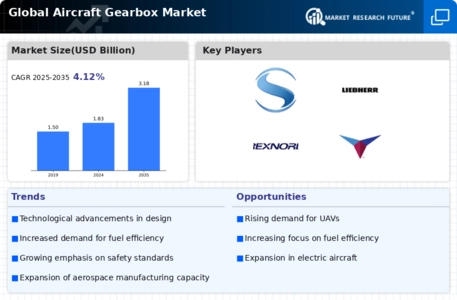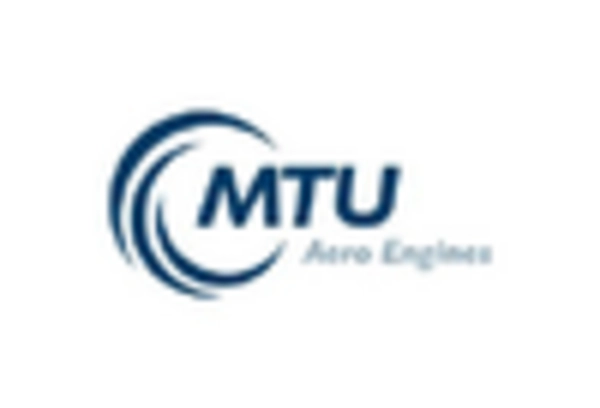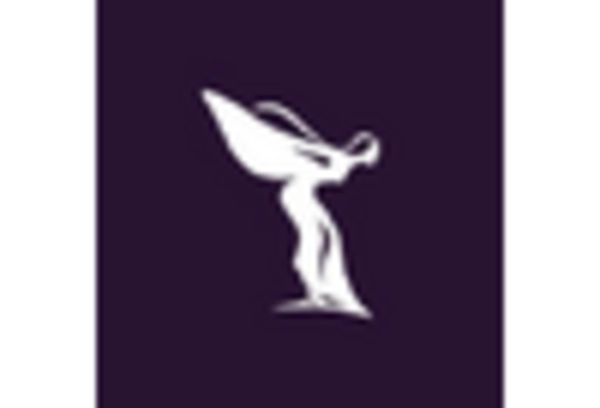-
Executive Summary
-
Market Attractiveness Analysis
- Global Aircraft Gearbox Market, by End User
- Global Aircraft
-
Gearbox Market, by Gearbox Type
-
Type
-
Global Aircraft Gearbox Market, by Aircraft
-
Global Aircraft Gearbox Market, by Component
-
Global
-
Aircraft Gearbox Market, by Application
-
by Region
-
Global Aircraft Gearbox Market,
-
Market Introduction
-
Market Definition
-
Scope
-
of the Study
-
Market Structure
-
Key Buying Criteria
-
Market Factor Indicator Analysis
-
Research Methodology
-
Research
-
Process
-
Primary Research
-
Secondary Research
-
Market
-
Application Estimation
-
Forecast Model
-
List of Assumptions
-
Market Insights
-
Market Dynamics
-
Introduction
-
Drivers
- Increasing air traffic
- Growing demand for new aircraft
- Drivers Impact Analysis
-
Rising demand for lightweight aircraft components
-
Restraints
- Issues related to spalling, frosting and manufacturing
- High cost of development
- Restraints Impact Analysis
-
defects
-
Opportunities
-
Market/Technological Trends
-
Patent Trends
-
Regulatory Landscape/Standards
-
Market Factor Analysis
-
Supply
- R&D
- Manufacturing
- Distribution
- Post-Sales Monitoring
-
Chain Analysis
-
& Sales
-
Porter’s Five Forces
- Threat of New Entrants
- Bargaining Power of Suppliers
- Bargaining Power of Buyers
- Threat of Substitutes
-
Analysis
-
Intensity of Rivalry
-
Global Aircraft Gearbox Market, by End User
-
Introduction
-
OEM
-
Aftermarket
-
Global Aircraft Gearbox
-
Market, by Gearbox Type
-
Introduction
-
Accessory Gearbox
-
Reduction Gearbox
-
Actuation Gearbox
-
Tail Rotor Gearbox
-
Auxiliary Power Unit Gearbox
-
Others
-
Global Aircraft Gearbox Market,
-
by Aircraft Type
-
Introduction
-
Civil Aircraft
-
Military
-
Aircraft
-
Global Aircraft Gearbox Market, by Component
-
Introduction
-
Gears
-
Housing
-
Bearing
-
Others
-
Global
-
Aircraft Gearbox Market, by Application
-
Introduction
-
Engine
-
Airframe
-
Global Aircraft Gearbox Market, by Region
-
Introduction
-
North America
- US
- Canada
-
Europe
- Germany
- France
- Italy
- Russia
- Rest of Europe
-
UK
-
Asia-Pacific
- China
- Japan
- South Korea
- Rest of Asia-Pacific
-
India
-
Rest of the World
- Latin America
- Middle East &
-
Africa
-
Competitive Landscape
-
Competitive Overview
-
Competitor Dashboard
-
Major Growth Strategies in the Global Aircraft Gearbox
-
Market
-
Competitive Benchmarking
-
Market Share Analysis
-
Leading Player in Terms of Number of Developments in the Global Aircraft Gearbox
-
Market
-
Key Developments & Growth Strategies
- Product
- Mergers & Acquisitions
-
Launches/Service Deployments
-
Joint Ventures
-
Company Profiles
-
Key Market Players
-
(Company
-
overview, products & services offered, financial overview, key developments,
-
SWOT analysis, and key strategies to be covered for public companies)
-
Safran
-
Liebherr
-
Raytheon Technologies Corporation
-
Rexnord Corporation
-
Triumph Group
-
Rolls-Royce plc
-
PBS Group, a. s.
-
CEF Industries, LLC
-
AERO GEAR
-
ZF Luftfahrttechnik GmbH
-
Other Prominent Players
-
Avion Group
-
Northstar Aerospace
-
AeroControlex
-
AERO GEARBOX INTERNATIONAL
-
SKF
-
Avio S.p.A.
-
Appendix
-
References
-
Related Reports
-
List of Abbreviations
-
-
List of Tables
-
List of Assumptions
-
Major Patents Granted for Aircraft Gearbox
-
(2020–2030)
-
Global Aircraft Gearbox Market, by End User, 2020–2030
-
(USD Million)
-
Global Aircraft Gearbox Market, by Gearbox Type, 2020–2030(USD
-
Million)
-
Global Aircraft Gearbox Market, by Aircraft Type, 2020–2030
-
(USD Million)
-
Global Aircraft Gearbox Market, by Component, 2020–2030
-
(USD Million)
-
Global Aircraft Gearbox Market, by Application, 2020–2030
-
(USD Million)
-
Global Aircraft Gearbox Market, by Region, 2020–2030
-
(USD Million)
-
North America: Aircraft Gearbox Market, by Country, 2020–2030(USD
-
Million)
-
North America: Aircraft Gearbox Market, by End User, 2020–2030
-
(USD Million)
-
North America: Aircraft Gearbox Market, by Gearbox Type,
-
North America: Aircraft Gearbox Market,
-
by Aircraft Type, 2020–2030 (USD Million)
-
North America: Aircraft
-
Gearbox Market, by Component, 2020–2030 (USD Million)
-
North
-
America: Aircraft Gearbox Market, by Application, 2020–2030 (USD Million)
-
US: Aircraft Gearbox Market, by End User, 2020–2030 (USD Million)
-
US: Aircraft Gearbox Market, by Gearbox Type, 2020–2030 (USD Million)
-
US: Aircraft Gearbox Market, by Aircraft Type, 2020–2030 (USD Million)
-
US: Aircraft Gearbox Market, by Component, 2020–2030 (USD Million)
-
US: Aircraft Gearbox Market, by Application, 2020–2030 (USD Million)
-
Canada: Aircraft Gearbox Market, by End User, 2020–2030 (USD Million)
-
Canada: Aircraft Gearbox Market, by Gearbox Type, 2020–2030 (USD
-
Million)
-
Canada: Aircraft Gearbox Market, by Aircraft Type, 2020–2030
-
(USD Million)
-
Canada: Aircraft Gearbox Market, by Component, 2020–2030
-
(USD Million)
-
Canada: Aircraft Gearbox Market, by Application, 2020–2030
-
(USD Million)
-
Europe: Aircraft Gearbox Market, by Country, 2020–2030
-
(USD Million)
-
Europe: Aircraft Gearbox Market, by End User, 2020–2030
-
(USD Million)
-
Europe: Aircraft Gearbox Market, by Gearbox Type, 2020–2030
-
(USD Million)
-
Europe: Aircraft Gearbox Market, by Aircraft Type, 2020–2030
-
(USD Million)
-
Europe: Aircraft Gearbox Market, by Component, 2020–2030
-
(USD Million)
-
Europe: Aircraft Gearbox Market, by Application, 2020–2030
-
(USD Million)
-
UK: Aircraft Gearbox Market, by End User, 2020–2030
-
(USD Million)
-
UK: Aircraft Gearbox Market, by Gearbox Type, 2020–2030
-
(USD Million)
-
UK: Aircraft Gearbox Market, by Aircraft Type, 2020–2030
-
(USD Million)
-
UK: Aircraft Gearbox Market, by Component, 2020–2030
-
(USD Million)
-
UK: Aircraft Gearbox Market, by Application, 2020–2030
-
(USD Million)
-
Germany: Aircraft Gearbox Market, by End User, 2020–2030
-
(USD Million)
-
Germany: Aircraft Gearbox Market, by Gearbox Type, 2020–2030
-
(USD Million)
-
Germany: Aircraft Gearbox Market, by Aircraft Type,
-
Germany: Aircraft Gearbox Market, by
-
Component, 2020–2030 (USD Million)
-
Germany: Aircraft Gearbox
-
Market, by Application, 2020–2030 (USD Million)
-
France: Aircraft
-
Gearbox Market, by End User, 2020–2030 (USD Million)
-
France:
-
Aircraft Gearbox Market, by Gearbox Type, 2020–2030 (USD Million)
-
TABLE
-
France: Aircraft Gearbox Market, by Aircraft Type, 2020–2030 (USD Million)
-
France: Aircraft Gearbox Market, by Component, 2020–2030 (USD Million)
-
France: Aircraft Gearbox Market, by Application, 2020–2030 (USD
-
Million)
-
Italy: Aircraft Gearbox Market, by End User, 2020–2030
-
(USD Million)
-
Italy: Aircraft Gearbox Market, by Gearbox Type, 2020–2030
-
(USD Million)
-
Italy: Aircraft Gearbox Market, by Aircraft Type, 2020–2030
-
(USD Million)
-
Italy: Aircraft Gearbox Market, by Component, 2020–2030
-
(USD Million)
-
Italy: Aircraft Gearbox Market, by Application, 2020–2030
-
(USD Million)
-
Russia: Aircraft Gearbox Market, by End User, 2020–2030
-
(USD Million)
-
Russia: Aircraft Gearbox Market, by Gearbox Type, 2020–2030
-
(USD Million)
-
Russia: Aircraft Gearbox Market, by Aircraft Type, 2020–2030
-
(USD Million)
-
Russia: Aircraft Gearbox Market, by Component, 2020–2030
-
(USD Million)
-
Russia: Aircraft Gearbox Market, by Application, 2020–2030
-
(USD Million)
-
Rest of Europe: Aircraft Gearbox Market, by End User,
-
Rest of Europe: Aircraft Gearbox Market,
-
by Gearbox Type, 2020–2030 (USD Million)
-
Rest of Europe: Aircraft
-
Gearbox Market, by Aircraft Type, 2020–2030 (USD Million)
-
Rest
-
of Europe: Aircraft Gearbox Market, by Component, 2020–2030 (USD Million)
-
Rest of Europe: Aircraft Gearbox Market, by Application, 2020–2030
-
(USD Million)
-
Asia-Pacific: Aircraft Gearbox Market, by Country, 2020–2030
-
(USD Million)
-
Asia-Pacific: Aircraft Gearbox Market, by End User,
-
Asia-Pacific: Aircraft Gearbox Market,
-
by Gearbox Type, 2020–2030 (USD Million)
-
Asia-Pacific: Aircraft
-
Gearbox Market, by Aircraft Type, 2020–2030 (USD Million)
-
Asia-Pacific:
-
Aircraft Gearbox Market, by Component, 2020–2030 (USD Million)
-
TABLE
-
Asia-Pacific: Aircraft Gearbox Market, by Application, 2020–2030 (USD Million)
-
China: Aircraft Gearbox Market, by End User, 2020–2030 (USD Million)
-
China: Aircraft Gearbox Market, by Gearbox Type, 2020–2030 (USD
-
Million)
-
China: Aircraft Gearbox Market, by Aircraft Type, 2020–2030
-
(USD Million)
-
China: Aircraft Gearbox Market, by Component, 2020–2030
-
(USD Million)
-
China: Aircraft Gearbox Market, by Application, 2020–2030
-
(USD Million)
-
India: Aircraft Gearbox Market, by End User, 2020–2030
-
(USD Million)
-
India: Aircraft Gearbox Market, by Gearbox Type, 2020–2030
-
(USD Million)
-
India: Aircraft Gearbox Market, by Aircraft Type, 2020–2030
-
(USD Million)
-
India: Aircraft Gearbox Market, by Component, 2020–2030
-
(USD Million)
-
India: Aircraft Gearbox Market, by Application, 2020–2030
-
(USD Million)
-
Japan: Aircraft Gearbox Market, by End User, 2020–2030
-
(USD Million)
-
Japan: Aircraft Gearbox Market, by Gearbox Type, 2020–2030
-
(USD Million)
-
Japan: Aircraft Gearbox Market, by Aircraft Type, 2020–2030
-
(USD Million)
-
Japan: Aircraft Gearbox Market, by Component, 2020–2030
-
(USD Million)
-
Japan: Aircraft Gearbox Market, by Application, 2020–2030
-
(USD Million)
-
South Korea: Aircraft Gearbox Market, by End User, 2020–2030
-
(USD Million)
-
South Korea: Aircraft Gearbox Market, by Gearbox Type,
-
South Korea: Aircraft Gearbox Market,
-
by Aircraft Type, 2020–2030 (USD Million)
-
South Korea: Aircraft
-
Gearbox Market, by Component, 2020–2030 (USD Million)
-
South
-
Korea: Aircraft Gearbox Market, by Application, 2020–2030 (USD Million)
-
Rest of Asia-Pacific: Aircraft Gearbox Market, by End User, 2020–2030
-
(USD Million)
-
Rest of Asia-Pacific: Aircraft Gearbox Market, by Gearbox
-
Type, 2020–2030 (USD Million)
-
Rest of Asia-Pacific: Aircraft
-
Gearbox Market, by Aircraft Type, 2020–2030 (USD Million)
-
Rest
-
of Asia-Pacific: Aircraft Gearbox Market, by Component, 2020–2030 (USD Million)
-
Rest of Asia-Pacific: Aircraft Gearbox Market, by Application, 2020–2030
-
(USD Million)
-
Rest of the World: Aircraft Gearbox Market, by Region,
-
Rest of the World: Aircraft Gearbox
-
Market, by End User, 2020–2030 (USD Million)
-
Rest of the World:
-
Aircraft Gearbox Market, by Gearbox Type, 2020–2030 (USD Million)
-
TABLE
-
Rest of the World: Aircraft Gearbox Market, by Aircraft Type, 2020–2030
-
(USD Million)
-
Rest of the World: Aircraft Gearbox Market, by Component,
-
Rest of the World: Aircraft Gearbox
-
Market, by Application, 2020–2030 (USD Million)
-
Latin America:
-
Aircraft Gearbox Market, by End User, 2020–2030 (USD Million)
-
TABLE 99
-
Latin America: Aircraft Gearbox Market, by Gearbox Type, 2020–2030 (USD Million)
-
Latin America: Aircraft Gearbox Market, by Aircraft Type, 2020–2030
-
(USD Million)
-
Latin America: Aircraft Gearbox Market, by Component,
-
Latin America: Aircraft Gearbox Market,
-
by Application, 2020–2030 (USD Million)
-
Middle East & Africa:
-
Aircraft Gearbox Market, by End User, 2020–2030 (USD Million)
-
TABLE 104
-
Middle East & Africa: Aircraft Gearbox Market, by Gearbox Type, 2020–2030
-
(USD Million)
-
Middle East & Africa: Aircraft Gearbox Market,
-
by Aircraft Type, 2020–2030 (USD Million)
-
Middle East &
-
Africa: Aircraft Gearbox Market, by Component, 2020–2030 (USD Million)
-
Middle East & Africa: Aircraft Gearbox Market, by Application, 2020–2030
-
(USD Million)
-
The Most Active Players in the Global Aircraft Gearbox
-
Market
-
Contracts & Agreements
-
Mergers & Acquisitions
-
Product/Service Developments
-
Expansions & Components
-
Joint Ventures & Partnerships
-
-
List of Figures
-
Market Synopsis
-
Global Aircraft Gearbox Market: Market
-
Attractiveness Analysis
-
Global Aircraft Gearbox Market Analysis, by
-
End User
-
Global Aircraft Gearbox Market Analysis, by Gearbox Type
-
Global Aircraft Gearbox Market Analysis, by Aircraft Type
-
Figure
-
Global Aircraft Gearbox Market Analysis, by Component
-
Global Aircraft
-
Gearbox Market Analysis, by Application
-
Global Aircraft Gearbox Market
-
Analysis, by Region
-
Global Aircraft Gearbox Market: Market Structure
-
Key Buying Criteria for Aircraft Gearbox Technologies
-
Figure 11
-
Research Process of MRFR
-
North America: Market Application &
-
Market Share, by Country, 2020 vs 2030
-
Europe: Market Application
-
& Market Share, by Country, 2020 vs 2030
-
Asia-Pacific: Market
-
Application & Market Share, by Country, 2020 vs 2030
-
Rest of
-
the World: Market Application & Market Share, by Region, 2020 vs 2030
-
Figure
-
Market Dynamics Overview
-
Drivers Impact Analysis: Global Aircraft
-
Gearbox Market
-
Restraints Impact Analysis: Global Aircraft Gearbox
-
Market
-
Porter’s Five Forces Analysis of the Global Aircraft
-
Gearbox Market
-
Supply Chain: Global Aircraft Gearbox Market
-
Figure
-
Global Aircraft Gearbox Market Share, by End User, 2020 (% Share)
-
Figure
-
Global Aircraft Gearbox Market Share, by Gearbox Type, 2020 (% Share)
-
Figure
-
Global Aircraft Gearbox Market Share, by Aircraft Type, 2020 (% Share)
-
Figure
-
Global Aircraft Gearbox Market Share, by Component, 2020 (% Share)
-
Figure
-
Global Aircraft Gearbox Market Share, by Application, 2020 (% Share)
-
Figure
-
Global Aircraft Gearbox Market Share, by Region, 2020 (% Share)
-
Figure 27
-
North America: Aircraft Gearbox Market Share, by Country, 2020 (% Share)
-
Figure
-
Europe: Aircraft Gearbox Market Share, by Country, 2020 (% Share)
-
Figure
-
Asia-Pacific: Aircraft Gearbox Market Share, by Country, 2020 (% Share)
-
Figure
-
Rest of the World: Aircraft Gearbox Market Share, by Region, 2020 (% Share)
-
Competitor Dashboard: Global Aircraft Gearbox Market
-
Figure 32
-
Capital Market Ratios and Financial Matrix
-
Contracts & Agreements:
-
The Major Strategy Adopted by Key Players in the Global Aircraft Gearbox Market
-
Benchmarking of Major Competitors
-
Major Service Providers
-
Market Share Analysis, 2020

















Leave a Comment